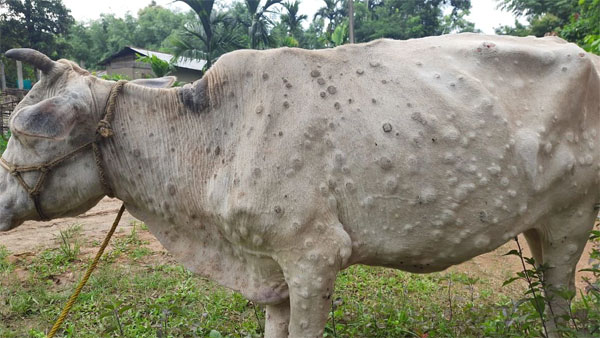
Explained: What is Lumpy Skin Disease? Can humans get infected with it?
Jaipur, Aug 05: The lumpy skin disease among animals has spread at an alarming speed in Rajasthan where more than 4,000 animals, mainly cows, have died due to it and over 90,000 have been infected.
Rajasthan Chief Minister Ashok Gehlot has urged the central government to provide financial and necessary assistance to save cows in the state from lumpy skin disease. "The state government is taking all possible measures to control the disease. The chief minister has appealed to the Centre to provide financial assistance to control the spread of the infection," according to an official statement.Gehlot has also appealed to gaushala operators, public representatives and voluntary organisations to cooperate with the state government to control and prevent the disease.

Last month, the outbreak had spread in 14 out of 33 districts of Gujarat. By 25 July, more than 37,000 cases and 1000 deaths in cattle were reported.
What
is
Lumpy
skin
disease?
Lumpy
skin
disease
(LSD)
is
an
infectious
disease
in
cattle
caused
by
a
virus
of
the
family
Poxviridae,
also
known
as
Neethling
virus.
It
is
genetically
related
to
the
goatpox
and
sheeppox
virus
family.

The disease is characterized by fever, enlarged superficial lymph nodes and multiple nodules (measuring 2-5 centimetres (1-2 in) in diameter) on the skin and mucous membranes (including those of the respiratory and gastrointestinal tracts).
Infected cattle also may develop edematous swelling in their limbs and exhibit lameness.
Lumpy
skin
disease
can
lead
to
significant
economic
losses
since
affected
animals
tend
to
have
permanent
damage
to
their
skin,
lowering
the
commercial
value
of
their
hide.
Additionally,
the
disease
often
results
in
chronic
debility,
reduced
milk
production,
poor
growth,
infertility,
abortion,
and
sometimes
death.
The
disease
has
been
reporeted
in
several
Indian
states
like
Assam,
Odisha,
Maharashtra,
Kerala,
Karnataka,
Chhattisgarh,
Madhya
Pradesh,
etc.
Lumpy
Skin
Disease:
Signs
and
Symptoms
Onset
of
fever
occurs
almost
one
week
after
infection
by
the
virus.
This
initial
fever
may
exceed
41
°C
(106
°F)
and
persist
for
one
week.
At
this
time,
all
of
the
superficial
lymph
nodes
become
enlarged.
The
nodules,
in
which
the
disease
is
characterized
by,
appear
seven
to
nineteen
days
after
virus
inoculation.
Coinciding
with
the
appearance
of
the
nodules,
discharge
from
the
eyes
and
nose
becomes
mucopurulent.
Susceptbile
hosts
Lumpy
skin
disease
is
host-specific,
causing
natural
infection
in
cattle
and
Asian
water
buffalo
(Bubalus
bubalis).
Lumpy
skin
disease
does
not
affect
humans.
How
the
disease
spreads
The
transmission
of
LSD
is
not
completely
understood.
The
main
two
routes
of
transmission
are
mechanical
transmission
by
arthropod
vectors
such
as
mosquitoes,
ticks
and
biting
flies
and
the
movement
of
infected
animals.
The
disease
can
also
be
spread
by
fomites
through
such
things
as
contaminated
equipment
and
in
some
cases
directly
from
animal
to
animal.
The disease has shown its ability to establish and spread in a wide range of environmental and productions systems around the world.
The Lumpy Skin Disease spreads through bloodsucking insects, certain species of flies and through contaminated food and water.
Can
humans
get
infected
with
Lumpy
Skin
Disease
LSDV
is
highly
host-specific
and
causes
disease
only
in
cattle
(Bos
indicus
and
B.
taurus)
and
water
buffalo
(Bubalus
bubalis).
It
does
not
cause
disease
in
humans.
Also,
there
is
no
risk
from
consuming
beef
or
dairy
products.
A study in Ethiopia showed evidence of differential breed susceptibility to LSD, with Holstein Friesian or crossbred cattle exhibiting higher morbidity and mortality due to LSD when compared with local zebu cattle. LSDV is not zoonotic, so humans cannot get affected by the disease.
Vaccination
There
is
no
vaccination
available
for
the
disease
which
is
being
treated
based
on
symptoms.
Eradication
of
LSD
is
difficult
and
early
detection
is
essential
for
successful
control
and
eradication.
Measures to taken on farm in case of suspicion
- If possible, separate the suspected case(s) from the rest of the herd.
- If possible, separate the rest of the animals from neighbouring herd(s) by feeding them on the farm and avoiding communal grazing
- Disinfect your hands, footwear, and outfit using any common disinfectant and when at home/farm wash the clothes at +60 °C.
- Disinfect equipment and materials used in the affected holding.
- Contact your veterinarian for support.
Prevention
A
careful
surveillance
of
the
disease
onset
and
spread
is
to
be
taken
up
at
the
farm
level.
Purchase
of
new
animals
that
are
either
incubating
the
disease
or
are
viraemic
without
exhibiting
any
symptoms
presents
a
major
risk
of
introducing
the
disease
into
a
naïve
herd.
Introduction
of
new
animals
into
herds
should
therefore
be
limited.
Stock
should
be
bought
only
from
trusted
sources.
New
animals
should
be
examined
and
declared
free
of
clinical
signs
prior
to
movement
and
on
arrival,
and
should
be
kept
separated/quarantined
from
the
herd
for
at
least
28
days
In affected villages, cattle herds should be kept separate from other herds by avoiding communal grazing.
Cattle should be treated regularly with insect repellents to minimize the risk of vector transmission of the disease. This measure cannot fully prevent transmission but may reduce the risk.
Limiting vector breeding sites such as standing water sources, slurry and manure, and improving drainage in holdings are sustainable, affordable and environmentally friendly ways of reducing the number of vectors on and around cattle.
How
long
does
lumpy
skin
disease
take
to
heal?
Complete
recovery
may
take
several
months
and
may
be
prolonged
when
secondary
bacterial
infections
occur.
Treatment
is
directed
at
preventing
or
controlling
secondary
infection.
It
may
take
up
to
6
months
for
animals
severely
affected
by
LSD
virus
to
recover
fully.


 Click it and Unblock the Notifications
Click it and Unblock the Notifications


































